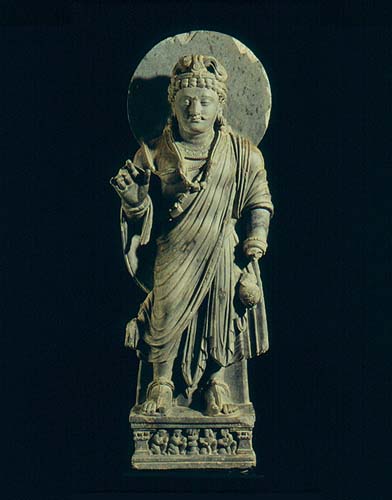

The Bodhisattva Maitreya, Gandhara region, Kushan period, 2nd / 3rd c. CE
Source: http://asianart.com/eskenazi/maitreya.html
(downloaded Feb. 2001)
"Bodhisattva Maitreya. Gandhara region, north-eastern Pakistan. Kushan period, 2nd/3rd century. Grey schist. Height: 93cm."
Commentary by John Eskenazi, Ltd., the gallery displaying this statue:
"This imposing image of the Bodhisattva is distinguished by the rich dress and jewellery of a contemporary Kushan prince or nobleman. The princely bearing is further emphasised by the powerful, fleshy torso, the rounded breasts and abdomen and the long, flowing hair looped in a chignon at the crown resembling an earlier Greek style (Krobylos) and held by a beaded pearl diadem. The idealised facial features with finely curving eyebrows, urna and half-closed eyes give the effect of contemplation and serenity. The strong round chin, straight nose and the elegant twirling moustache suggest the mixture of races and cosmopolitan nature of Gandharan art and culture. The right arm is in abhaya mudra and the left hand, now missing, held a water pot, kundika, containing amrita, the elixir of life, and is a symbolic promise of salvation in the future, the spiritual role of the Bodhisattva Maitreya.The relaxed pose and worldly attire represent the Bodhisattva's continuing association with mankind as, through compassion, he has voluntarily postponed his own achievement of nirvana in order to devote his superhuman powers to relieve suffering and further the spiritual progress of others. The juxtaposition of distinctly Western classical features such as the realistic and ridged rendering of the drapery with the stylised indigenous treatment of the face and body typifies the Gandhara rendition of the Bodhisattva image. A delicate and balanced synthesis is achieved even within specific features, as, for example, in the modelling of the torso which combines classically inspired indications of musculature with the idealised, typically Indian portrayal of breath control, prana, along with princely wealth and power represented by the slightly swelling abdomen. It may be argued that the Bodhisattva's fine clothes, dressed hair and elaborate jewellery, together symbolic of worldly involvement, affirm the strength of the aristocratic and merchant lay community who were more attracted by material goods and display than the austere lifestyle of the monastery and acted as patrons for these images."